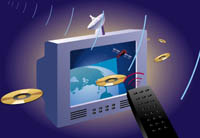Imagine being able to turn your television on, pick the program you want to see from your customized pre-recorded list, pull up an on-screen menu to check the latest weather and stock quotes, instant-message a friend, order pizza from your remote control, and book your next vacation, all without leaving your couch.
Welcome to the world of interactive television. The idea of having consumers actively engage in the television experience isn’t new. After all, shopping channels like QVC have turned viewer-to-buyer conversion into a science. Cable and satellite systems have greatly increased the number of channels available to consumers, and pay-per-view (PPV), where viewers use the telephone to rent access to certain programs, is a fixture at most hotels. In an effort to drive traffic to the Internet, television-show hosts often exhort viewers to log on to web sites and take companion surveys, enter sweepstakes and download recipes. More recently, the spotlight has been on personal video recording (PVR) technology, which is offered by devices like TiVo and SONICBlue’s ReplayTV. These products take the VCR one step further, offering hard-disk-based recording of favorite programs, pause-and-rewind capabilities for live television, and the ability to skip commercials during playback. In Europe and elsewhere, satellite system providers such as BSkyB and Canal Satellite are offering enhanced features, including t-commerce applications, to their customers. By connecting their set-top box to their phone line, viewers can access e-mail, shop, bank, place bets, and more. Many providers are also experimenting with video-on-demand (VOD), which allows consumers to request and view content whenever they want without having to record it first.Ask, and Ye Shall Receive“Video on demand is the next big thing,” says Gerald Faulhaber, professor of public policy and management at Wharton. “It will change the way people watch TV. We’re going to start moving away from a traditional model of channels, each of which carries a 24-7 video stream, toward a model where people request shows they want to see. There probably still will be channels (after all, you have to see Buffy the Vampire Slayer somewhere for the first time) but this is going to be a sea change in the industry.”For entertainment and cable companies, video-on-demand is more of a sound economic model than t-commerce, says Charles Benson, a 1996 graduate of Wharton and former vice president of Liberty Digital, a subsidiary of Liberty Media. “The most basic form is pay-per-view, where viewers call or click on the remote control to watch a previously scheduled program. Near-video-on-demand, or NVOD, uses the same PPV technology but the cable operator offers many more windows of the program – say, airing it every half-hour – so the consumer doesn’t have to wait too long to watch it at any given point. In true VOD, the consumer can start watching the movie whenever he wants, and is free to pause, rewind, or fast forward and watch it at will during a specific time window of, say six hours or twelve hours.“As for deployment, there are two schools of thought on VOD,” adds Benson. “One is a head-end based system, where the content is broadcast to the viewer in a stream from the cable operator’s server. The other is a model in which the content is downloaded to the viewer’s set-top box and resides there for a specific number of hours before it is automatically erased. I don’t know which model will win, but my guess is it may be the head-end based model so studios have some control over the content distribution.”Fast Forward Eddie Monnier, a 1996 graduate of Wharton and vice president of corporate development for Liberty Broadband Interactive Television, believes the device most likely to succeed will be a set-top box with user-friendly integrated PVR technology. “I consider myself quite technologically savvy, and I had some trouble setting up my stand-alone PVR to work with all the other systems I had,” he notes. “This stuff has to be very easy for consumers to set up.” Often, says Monnier, consumers don’t understand why they need something until they’re using it. “People who don’t have a PVR often wonder why they would ever want to pause or rewind live television. But skeptics said the same thing about the microwave, asking why they would ever need to bake a potato in eight minutes. Once they use it, it’s a different story. For instance, when I’m at a hotel while traveling for business and I don’t catch what someone said on the news, I instinctively reach for the remote to rewind – but then I remember that I can’t do that there as I can at home!” Laurence Marks, a 1996 graduate of Wharton and vice president for content development at Static, a subsidiary of OpenTV, notes that when the PVR is integrated with the set-top box, cable companies might balk at including the commercial-skipping feature. “Some of the cable companies’ money comes from firms to whom they sell advertising. It will be difficult for them to put that skip button on the remote controls.”Indeed, several entertainment companies have filed suit against SONICBlue, claiming that the ad-skipping technology in the ReplayTV device violates content-providers’ copyright. Five users, assisted by the Electronic Frontier Foundation, have countered by filing a suit against the entertainment companies, seeking to affirm their right to use their ReplayTV boxes to skip advertising and digitally record content. Show Me the Money Television can certainly influence consumers to buy products (Home Shopping Network and QVC are examples of success in that arena), but exactly how much commerce can be integrated into entertainment remains to be seen. “As for the classic example – viewers being given the opportunity to buy an article of clothing that Monica is wearing on Friends – I don’t think that will really materialize into an attractive business opportunity,” says Monnier. “There are two questions to be asked. One is: Do consumers want it? I think the answer is no — when they’re sitting down to be entertained, I’m not sure they want to switch from that into shopping mode. The second is: If consumers do want it, can you make a business out of it?” If one spins out the hypotheticals, notes Monnier, a lot of issues come up. “Suppose you want to sell a sweater that a character is wearing during one episode. How do you accurately predict demand? How long do you keep it in stock and maintain fulfillment, especially if the episode goes into reruns after it airs? Peaky inventory demand is a retailer’s nightmare. Look at catalog sales return rates for women’s apparel, and you’ll see the problems. Many people buy more than one size of something and return the ones they don’t want, for instance. So this isn’t necessarily a viable business model for interactive television.” Enhanced television features, however, might be a different story. Who is going to pay for these services? “It depends,” says Monnier. “Some types of programs and events have enthusiasts who would be willing to pay a subscription fee for access to multiple camera angles, instant replays and the like. Think NASCAR in the U.S., Formula One in Europe, or World Cup soccer anywhere in the world. In other cases, networks might offer these features, if they believe that such enhanced features will net them more advertising dollars or reduce churn among viewers.” Marks adds that in Europe, people pay for such services just as they do at the arcade, on a one-off basis. “BSkyB has made enormous amounts of revenue on sports betting and games. People pay in order to play a game, or to jump to different levels in a game, or whatever. If you can develop enough of a package of games, you’d want to move more to a subscription model. But consumers there are pretty happy with it as it is, with micropayments. Clearly, the European model is different because it’s not like the U.S. where the Internet on a PC is so entrenched and everyone expects everything free.” But even simple TV portals have run into stumbling blocks in the U.S., notes Benson. “The portal concept isn’t catching on so well because you need a more advanced set-top box for fancy user interfaces. There have been a lot of technology glitches in the software and middleware required, and program guide providers such as Gemstar-TV Guide often hold many of the patents on interactive guides. Sometimes their guide takes up so much memory that you can’t run too much else on the box,” he says.Faulhaber warns that exclusive deals in the U.S. might trigger scrutiny by the FCC. “If you’re the cable company, and AOL or Microsoft wants to do an interactive TV deal with you, it could be a nice additional revenue source. But if Microsoft wants to be the exclusive vendor of interactive TV with a certain company, customers don’t get a choice. The FCC might frown on such a deal.” The Web Channel?When it’s done correctly, Faulhaber believes, interactive television has the potential to bring the still-offline couch potato market to the Internet. “There are all kinds of reasons that many people are not connected to the Net, but everyone has a television set. It just has to be really entertaining and easy.” Just as hand-helds evolved from Newtons to Palms, he says, MSN TV and AOL TV will give way to more compelling interfaces when the time is right.But many feel that the television just isn’t the right device for a web-surfing experience. “I personally am not a believer in using television to surf the web,” says Monnier. “The web is completely a consumer pull experience; it is a one-to-one, active-mode experience where the user is at most 18 inches or so from the screen. Television, on the other hand, is a push experience. Interactive television will allow consumers to incorporate some pull into their TV viewing experience but it will still be a largely passive experience. The web allows you to call up massive amounts of information. Why would you do that on a television when, in most homes, you can do it on a personal computer?” “I think web-on-television has not been able to reach critical penetration levels because those who like getting that information on a television eventually just graduate to a PC. So getting the web on a TV just isn’t interesting,” says Monnier. Marks agrees. “It’s never going to be a huge hit unless you get compelling stuff for what can be termed passive-interactive people. It has to be very intuitive, and must be something they can engage in very easily.” Discomfort on Madison Avenue As users get more and more control of the television experience, where does that leave advertisers? “For advertisers, who are used to being able to schedule commercials at particular times, the idea of allowing people infinite flexibility to watch shows at other times may not fit with their scheme. So they might have to find ways to insert commercials through set-top boxes to these people who are constantly time-shifting,” says Joseph Turow, professor of communications at Penn’s Annenberg School for Communication. “Madison Avenue will increasingly have to prove its worth,” adds Monnier. “With such highly targeted ads and the accompanying technology, we can evaluate what people are viewing in unprecedented ways.” “I believe advertising will become truly targeted,” he notes. “Imagine a scenario where two consumer households are watching the same program. The young, single professional sees ads for a sports car, while the family with two children sees ads for a minivan. This is something advertisers have not been able to do before.” The technical feasibility of this, Monnier adds, is being proven in a trial currently being conducted by SpotOn, a joint effort by ACTV, Motorola and Wink, on an AT&T system. Benson agrees, and points out that good commercials do get viewed. “It will be a wake-up call for the advertisers to get more creative on their commercials. They have to figure out other ways to reach consumers. After all, we do sit and watch Superbowl ads. I’ve rewound and watched commercials even when using TiVo.”Random Access at a Price?Turow notes that the growing popularity of interactive television features raises interesting questions about viewership and about the viability of local TV stations. “Historically, we have been used to the idea of program flow, and entire schedules of shows are created with the idea of people continuously watching the lineup. The idea of flow is now changing. The network may become more of a brand that the consumer turns to just to consider which programs are worth adding to his personal schedule. If people are cherry-picking programs that way, they might not go to their local stations at all.”Interactive TV also poses questions on a societal level, says Turow. “We have society-making media (shared media which enable movement of people and ideas across groups) and segment-making media (media which crystallizes people’s sense of belonging to a niche). In a world dominated by niche media, it is increasingly possible to drill down only into areas that you care about, and dwell on particularistic interest groups, often excluding your neighbors. It’s a form of electronic gating. You can create or change programming based on whom you’re targeting. What does it mean to have a society in which the shared experience becomes less and less common?”How will the brave new world of interactive television change society? Tune in at a later date to find out.Looking for more insights?
Sign up to stay informed about our latest article releases.



